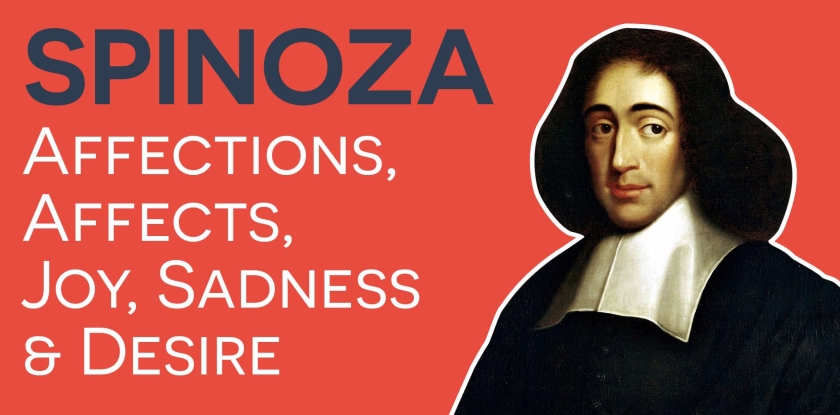
Hate is a sadness, accompanied by the idea of an external cause (Spinoza, 1994a, pp. 106, DVII)
There are so many “ideas of external causes” in the education system that it is probably no surprise that many sadnesses “accompany” them. For Spinoza, sadness is simply a decrease in one’s powers of action and so it embraces all the “negative” affects – if we can call them that. But it should be noted that Spinoza is not an “affective” prescriptivist; he does not say that we should be feeling a certain way. He does not advise against feeling “sadness” or any other affect. Moreover, he points out that any sadnesses that we feel are “necessary” in the sense that we are the inevitable recipients of them; they “act upon” us in the way all “passions” do. It is part of the pedagogue’s job to give the learner an adequate idea of them. This is particularly true of “hate” which is such an all-encompassing passion; it is closely related to “love” because both are affects which accompany the idea of an external cause. I think it is particularly important to consider certain external causes which may cause people in the education system to accompany their sad ideas with them.
Students and hate
Many students say they hate school. The whole system becomes their focus for sadness. As we have already seen, this may be because their “habitus” just does not fit in with the over-riding habitus of the system, and as a result, they hate many things about school: the nature of the lessons, the voices and bodies of the teachers, the instructions they receive, the powerlessness they feel. I have seen this happen in a few cases, but more often than not though, a particular incident or person triggers the hatred. This could be because they don’t like a particular teacher, subject or student. In my experience, the nature of the hatred is usually “human focused”. Usually, students feel that a key player in the system does not like them, and has “got it in for them”. We will look at the nature of these types of “fear” later, but here it is important to note that an effect of this kind of fear is burgeoning hatred for other things associated with school. Things that they treated with disdain or even love/joy now become external causes for hatred.

This diagram shows the factors that come into play when a student feels hate at school. Fear (which will be dealt with later) is linked to hate: fear of failure, fear of being humiliated, fear of physical/verbal violence etc. This fear then can affect a students’ mind in many other ways in that he/she looks for external causes for their sadness. Their powers of action have been decreased and they no longer feel joy in the things that they used to enjoy, and may well hate these things because they blame them in some way. For example, if they are being bullied they may well blame a friend who was a source of joy for not being supportive enough etc., and then hate them. The things that they disdain may well become ideas of external causes of sadness because they notice them now in this heightened affective state of fear. For example, the affect of finding certain lessons difficult or boring may well become a species of hate because they blame these things for the way they are feeling, which, of course, they don’t have an adequate understanding of.
Journey into Joy
When have you felt hate at school? What was the “accompanying external cause” in your view?
Teachers and hate
I have noticed that teachers tend to be more political in the way they focus their hatred. So, for example, many teachers hate the government for imposing endless new changes to exams, curriculum, assessment procedures, and curriculum etc. These teachers feel “acted upon”, passive recipients of pointless policies, and, as a result, they feel sadness, accompanied by the idea of the external cause of the government. Their feelings of hate are clearly related to their feelings of powerlessness. Perhaps more commonly, certain figures within a particular institution may become foci for hate, particularly other teachers who are perceived to be “bossing” people around unreasonably, possibly exhibiting bullying behaviour. Over the years, I have come across many teachers who have hated other members of staff, regularly coming up with comments like “I’d like to stab his eyes out”, “He is the most pathetic person I’ve ever met”. This discourse of hate pervades staffrooms in a whispering, covert fashion up and down the country, and possibly across the globe.
I would like to argue that this affect of hate is an inadequate idea which has been produced by a number of accompanying causes, and that it is in the interests of teachers to understand these causes before focusing their hate upon a particular person. Spinoza’s philosophy necessitates for us to gain an adequate idea of the affect of hate; to understand its multiple sources. I think in an atmosphere where jobs are insecure, where teachers’ authority is constantly contested, where teachers are judged by arbitrary benchmarks etc,, then the affect of hate is much more likely to be produced by an educational institution.
Journey into Joy
Why do you think teachers hate other colleagues? What is really going on here?
Learning and Aversion
Aversion is a sadness accompanied by the idea of something which is the accidental cause of sadness (Spinoza, 1994a, pp. 106, D. IX)
The affect of “aversion” afflicts many classrooms. Let’s start with the students. Many students may not “hate” a subject in that they explicitly blame it in their minds for being the direct cause of their sadness, but they may well feel that for accidental reasons, they don’t a subject. A very common phrase I’ve heard in my career is “I just don’t like it – it’s boring”. For me, these phrases are informed by the affect of aversion, rather than hatred; many students feel that for “random” reasons they don’t understand they don’t like a subject. This lessens the affect of sadness. Many children feel that they don’t adequately understand the reasons why they are learning something, and in this sense they feel aversion because they feel that they are learning things for “accidental” reasons: they just happen to have strayed upon this teacher who insists upon teaching these pointless things, when they might be learning something more interesting. Teachers try to compensate for this by saying that they are learning something for an exam, but children then feel that they are the victims of a “random” exam system. This is at the heart of many students’ ressentiment; they constantly subjected to be bombarded with random terms, facts, tasks.
Similarly, teachers may well not like teaching a class or a topic for “accidental” reasons. For example, they have to teach a class in a particular room which is cramped, or too hot/cold etc., and this makes them feel an aversion for the class which they feel is “accidental”. I think it’s interesting to note in my own case that this means my feelings of sadness are not so strong as they might have been if I had blamed the students themselves for my feelings.
I found as my career progressed, I developed an aversion for Parents’ Evenings, something which I had not felt at the beginning of my career. I think this was for a number of reasons. I think Parents’ Evenings had become much more “high stakes” affairs, with parents much more likely to blame the teacher if their child was doing badly. I also felt aversion because these Parents’ Evenings were at the end of a long day of teaching, and I wanted to go home, but would have to talk to parents for three hours or so, before the long trek home.
Journey into Joy
When have you felt that you’ve been forced to learn random facts/terms/topics? What things do you feel an aversion towards?
Humility
Humility is a sadness born of the fact that a man consider his own lack of power, or weakness. (pp. 108, D. XXVI)
The “affect” of humility is very different from having an adequate idea of what “humility” is. Schools are constantly casting its actors in roles which necessitate the affect of humility. The student has to feel humility much of the time because he/she knows that he/she has very little power; he/she has to attend school, and has little choice about what he/she learns. These power structures bred the affect of humility.
It’s strange as a teacher that I have felt the affect of humility many times. This is particularly the case when dealing with senior managers: headteachers, deputy heads, heads of department etc.. They have made me aware of my own lack of power: I have to follow their guidance, their advice whatever I might think of them. Instead of getting angry, I have found that the affect of humility has furthered my career with these people of worldly power; it’s conveyed in the way you accept what your superior says to you, the sincere nod of the head, the diligent way you follow their orders, the way you pay attention.
Journey into Joy
When have you felt humility in your life? What sorts of people have produced the affect of humility in you?












